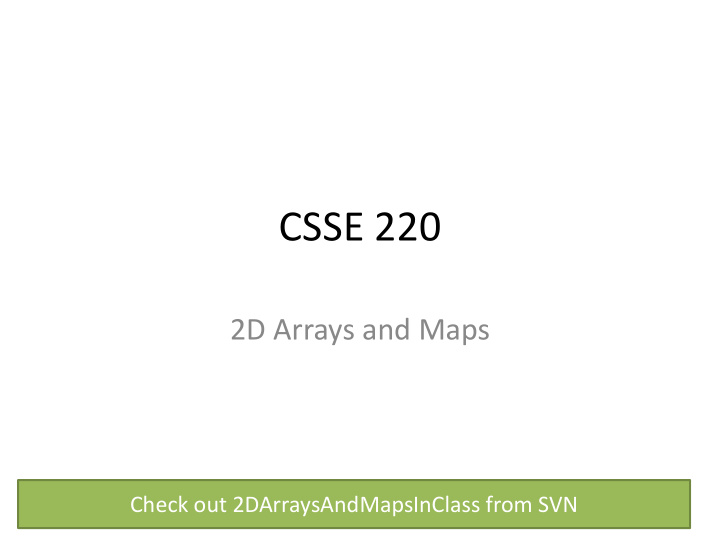



CSSE 220 2D Arrays and Maps Check out 2DArraysAndMapsInClass from SVN
An aside: academic honesty in CS • Please do not collaborate on homework assignments beyond what is allowed Definitely not OK • Looking at someone else’s solution, “just for a reference” as you write your own code • Pair programming on an individual assignment • Sitting next to someone as you both work on the assignment, working through any problems you have as a group
How much help is too much help? “So you loop across the array elements, getting each element Borderline and seeing if it’s in the hashtable. but OK If it is, you get the value and increment it…” “So you write a for loop, 1 to array length. Your key variable is gonna be array[i]. You check if Giving away the an hashMap.get(key) is null, if not, swer. Cheating. you get the value with get, then hashMap.put(key, oldValue + 1)…”
Penalties – they are severe • Automatic F in the course • Drop 1 letter grade • -100% score on assignment Yes, you can get an automatic F for cheating on one assignment one time. You should always credit anyone you get help from on an assignment. If you do, it lets me assign one of the weaker penalties.
2D Arrays – What, When, Why, How? What: • Think of them as an array of arrays • … or as a grid with rows & columns When: – Represent 2 dimensional data • Game Boards • Tables • Multiple lists of items • Etc.
2D Arrays – What, When, Why, How? Why: • Match your data representation as closely as possible to the real-world How: • char[][] ticTacToe = new char[3][3]; • Retrieving data – ticTacToe[0] Gets the first char[] – ticTacToe[1][2] Gets the second array’s third item
2D Arrays • Make groups of two (no more than 3, no one can work alone) • Read through the 3 2D Array sample problems with your partner and make sure you both understand how they work • Then use the code as an example to answer the 2D Array quiz questions • Then do the 2d sample problems • Call me over when you’re finished
Maps – What, When, Why, How? What: • Collection of key-value pairs – Key is the identifier • i.e. A word in a dictionary, or a student ID number, something that uniquely identifies an item – Value is the data for that identifier • i.e. The definition of a word in a dictionary, a Student object for an ID, the value associated with an unique ID • Think of this like a dictionary (in some programming languages they’re even called dictionaries) – Key: word – Value: definition
Maps – What, When, Why, How? When: • We use maps when a unique piece of data is used to retrieve additional information Why: • Fast access to information based on a unique key How: HashMap<String, Student> usernameToStudent = new HashMap<String, Student>();
Maps • Sometimes, it’s difficult to fully understand maps. • Let’s do an example together: – Implement an int array using a map.
Maps • Make groups of two (no more than 3, no one can work alone) • Read through the 3 Map sample problems with your partner and make sure you both understand how they work • Then use the code as an example to answer the Map quiz questions • Then solve the map problems in today’s code • Call me over when you’re finished
Recommend
More recommend